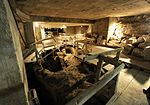New Church of the Theotokos

The New Church of the Theotokos, or New Church of the Mother of God, was a Byzantine church erected in Jerusalem by Emperor Justinian I (r. 527–565). Like the later Nea Ekklesia (Νέα Ἐκκλησία) in Constantinople, it is sometimes referred to in English as "the Nea" or the "Nea Church". The church was completed in 543 but was severely damaged or destroyed during the Persian conquest of the city in 614. It was further used as a source of building material by the Umayyads a few decades later. Meager remains of the once huge church were discovered at excavations in the Old City's Jewish Quarter, with the southeast corner slightly protruding outside the 16th-century city walls.
Excerpt from the Wikipedia article New Church of the Theotokos (License: CC BY-SA 3.0, Authors, Images).New Church of the Theotokos
Heil HaHandasa, Jerusalem Morasha
Geographical coordinates (GPS) Address Nearby Places Show on map
Geographical coordinates (GPS)
| Latitude | Longitude |
|---|---|
| N 31.773416666667 ° | E 35.231566666667 ° |
Address
העיר העתיקה בירושלים וחומותיה
Heil HaHandasa
9511208 Jerusalem, Morasha
Jerusalem District, Israel
Open on Google Maps








